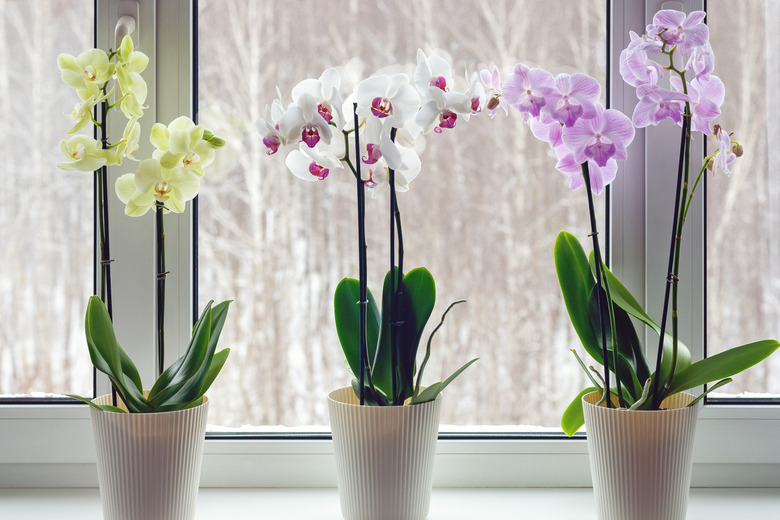When Are Orchids In Season?
We may receive a commission on purchases made from links.
Orchids (family Orchidaceae) provide gorgeous blooms for your house and patio. Most orchids bloom seasonally, but some will flower again after their peak season with the right care.
Tip
Orchids grown as potted plants have varied blooming seasons, depending on their species. The most common time for orchids to reach peak blooming season is March, but there are also varieties that bloom in winter, summer or fall.
Peak Orchid Blooming
Peak Orchid Blooming
March is the peak blooming season for the most commonly grown orchid houseplants. Moth orchids (Phalaenopsis Group, USDA zones 10-12) bloom abundantly in March, and the blooms last for several months. Bloom time can vary according to weather conditions, however. And some moth orchid hybrids bloom in January or even in time for the December holidays.
Many cat orchid hybrids (Cattleya Group, zones 10-12) bloom in March or April. March is the time when orchids can be at their most showy because some winter varieties are still blooming, while early spring varieties are just beginning to come into flower.
There are some orchids that bloom in winter, as long as the temperature is a minimum of 50 to 65 degrees Fahrenheit. This is when lady slipper orchids (Paphiopedilum Group, zones 9-12) hybrids are at their peak. Boat orchids (Cymbidium Group, zones 10-12) are well into their flowering season in January and February, but these orchids suffer damage below 30 degrees F, so make sure these are not kept outdoors if you live in an area with cold winter temperatures.
Caring for Orchids
Caring for Orchids
Paying attention to peak bloom season is important for orchids not only for the display of flowers but for their care. You want to repot winter and spring blooming Cattleyas immediately after blooming has ended.
March is also the best time to repot Paphiopedilum orchids. By this time, these popular winter blooming orchids have finished blooming. Clean the plant of dead and dying foliage and repot in fresh potting mix. Orchids do best when repotted after each blooming, usually because the potting medium breaks down. Occasionally, orchids outgrow their container and need larger containers.
Orchids are sensitive about potting mixture and should be repotted in well-drained potting mix that also retains water well. Most orchids should be potted in sphagnum peat moss or bark chips. Peat moss retains water well, but take care not to overwater. Bark is a good choice for orchids that do best when they dry out between waterings.
Summer and Fall Flowering Orchids
Summer and Fall Flowering Orchids
With proper care, some orchid varieties will brighten up your house or patio in the summer and fall months. Cymbidium will provide beautiful summer flowers, while Cycnoches will provide fragrant, large fall blooms.
In summer, some orchids native to high elevation areas will need to be shaded, so make sure those outdoor or indoor orchids don't get too much sun. They also prefer higher humidity levels. Summer is when Odontocidium, Wilsonara and Colmanara will bloom, and all prefer shady areas.
Early fall is a good season for Dendrobium hybrids and Rhynchostele bictonensius. As fall progresses, many orchids are gearing up for winter blooming. After its first winter-blooming, Phaelaeonopsis may bloom again if you use a sharp pruner to cut off a stem, leaving two nodes or the lines on the stem below the spot where the flower formed. You may get another bloom within eight to 12 weeks.
More About Orchids
More About Orchids
Orchids typically need less water in winter than in summer, so pay attention to the orchid variety when you establish a watering pattern. When you repot an orchid, place the entire pot into a bucket of water for 10 to 15 minutes. Remove the plant and use pruners to trim off any old roots, dried foliage and potting mix.
Plant a variety of orchids in pots to have orchids blooming most of the year. Orchids like temperatures between 60 and 80 degrees with humidity levels at 50 percent or above. The humidity levels inside an air conditioned home may cause leaf and bloom problems, so a window above a kitchen sink may be the best location for an orchid plant when the AC is running.
Keep your orchids fertilized when not blooming to prepare them for blooming. Use a water-soluble fertilizer specifically formulated for orchids, and follow all label directions for mixing rates and application frequency.
